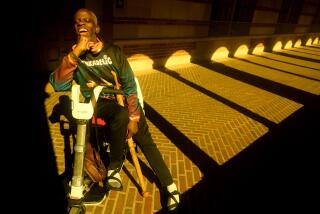An Exercise in the Shoes of Disabled
- Share via
GARDEN GROVE — Dr. Christine Mlot, a medical manager at the FHP Health Care in Garden Grove, clung to the elbow of a physical therapist as she plodded toward a low staircase wearing 10-pound weights on each ankle.
Once she had conquered the small stairway, she breathed a small sigh of relief. “My legs felt like lead,” Mlot said. “This really makes you think what it is like to be disabled.”
Before the staircase exercise, she had navigated a slalom course in a wheelchair using only her right arm for propulsion to simulate the condition of a stroke patient who has lost the use of the left side of the body. “It’s hard,” Mlot said, referring to her exercise.
In the parking lot of the Orangegrove Rehabilitation Center in Garden Grove on Wednesday, 70 physicians, health care specialists and ambulance drivers were put through an exercise course designed to simulate the disabilities experienced by their patients.
Before lifting herself out of the wheelchair, Mlot had to use a set of pincers to grab an article of clothing and dress herself using one arm.
“This really is worthwhile because I think that most people don’t appreciate the difficulty of being disabled,” Mlot said. “Most of my patients are 70 to 80, and old age is really hard with all the swollen legs and painful hips.”
The three-hour session was devised and run by the physical therapists who work regularly with about 60 disabled patients at the center.
“It is easy to take for granted the simple things in life,” said Rose King, a therapist who has been working at the center for six years. “These (simulations) are pretty close to reality except that the frustration factor is much higher for an actual patient. Also it takes a lot of endurance to, say, push yourself around in a wheelchair all day.”
Each participant went through a series of simulations that weakened legs, distorted vision and dulled the sense of touch. One of the more difficult exercises created a vision and speech impairment: Participants had to read aloud while wearing goggles smeared with petroleum jelly and holding two large marshmallows in their mouth.
Mike Kelley, regional manager for LifeFleet Ambulance in Anaheim, which transports injured and disabled patients throughout Orange County, said the training session would definitely “open my eyes to what is happening to the people riding in the back of my ambulance.”
He said that paramedics with the ambulance company are equipped to respond and aid people with injuries and disabilities but that they may never know exactly what those problems feel like firsthand.
“This is as close you can get to reality, but nothing is quite like actually living disabled,” he said.
More to Read
Sign up for Essential California
The most important California stories and recommendations in your inbox every morning.
You may occasionally receive promotional content from the Los Angeles Times.













